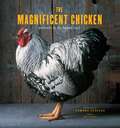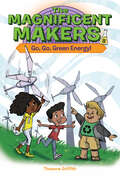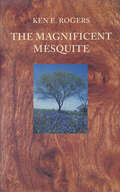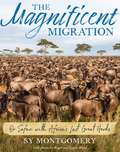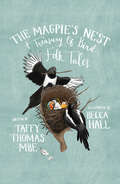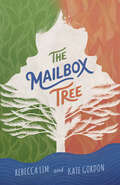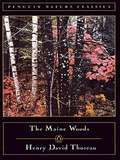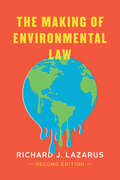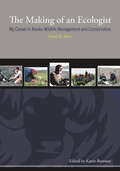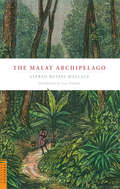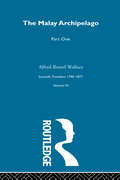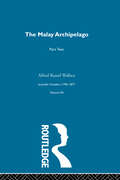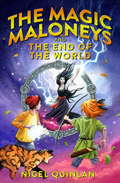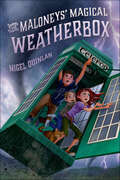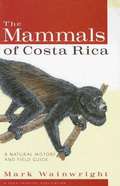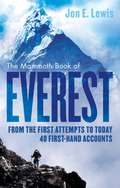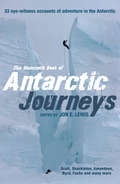- Table View
- List View
The Magnificent Chicken
by Tamara StaplesWith backyard chicken keeping and urban farming at an all-time high, the proudest of purebred poultry take center stage once again in this fully revised and expanded edition of the classic The Fairest Fowl, now retitled The Magnificent Chicken. Updated with even more chickens and an enlarged resource section, this celebration of the wonder, peculiarity, and magnificence of championship chickens showcases more than 40 astonishing breeds in glamorous photos--many brand new--and informative text, while an introduction by Ira Glass explores the finer points of poultry shows and chicken portraiture.
The Magnificent Makers #8: Go, Go, Green Energy! (The Magnificent Makers #8)
by Theanne GriffithBoom! Snap! Whiz! Zap! The Magnificent Makers is a fiction chapter book series filled with real science, adventure, and characters kids will love! Every book includes two science activities kids can do at home.A modern-day Magic School Bus for today's kids!Pablo, Violet, and their classmate Garry are on a field trip to the Environmental Science Center when they are transported to the Maker Maze! In the maze, they&’ll work with wacky scientist Dr. Crisp to complete three challenges all about wind, solar, and tidal energy. But then Violet begins to feel bad about how much energy she&’s been using. Can she, Pablo, and Garry learn how to use energy in a way that doesn't hurt the earth? In Go, Go, Green Energy!, the kids learn the importance of being mindful and never giving up. Don&’t miss the other books in the series! #1: How to Test a Friendship#2: Brain Trouble#3: Riding Sound Waves#4: The Great Germ Hunt#5: Race Through Space#6: Storm Chasers#7: Human Body Adventure
The Magnificent Mesquite (Corrie Herring Hooks Series)
by Ken E. RogersA reliable source of food and shelter even in the severest droughts, the mesquite tree sustained American Indians in the Southwest for centuries. Today, mesquite is popular for barbecuing, woodworking, furniture making, flooring, sculpture, jewelry, and food products ranging from honey to jelly and syrup. Even ranchers, who once fought to eradicate mesquite, have come to value its multiple uses on well-managed rangeland. In this book written especially for a general readership, one of the world's leading authorities on mesquite presents a wealth of information about its natural history and commercial, agricultural, and woodworking uses. Ken Rogers describes the life cycle, species, and wide distribution of the mesquite, which is native or naturalized not only in the Southwest and Mexico, but also in India, Africa, Australia, South America, and Hawaii. He discusses the many consumer and woodworker uses of mesquite at length-even giving instructions for laying a mesquite wood floor and making mesquite bean jelly. He also looks into the ways that people are using mesquite in nature, from rangeland management in the Southwest to desertification prevention in arid countries.
The Magnificent Mesquite (Corrie Herring Hooks Series)
by Ken E. RogersA reliable source of food and shelter even in the severest droughts, the mesquite tree sustained American Indians in the Southwest for centuries. Today, mesquite is popular for barbecuing, woodworking, furniture making, flooring, sculpture, jewelry, and food products ranging from honey to jelly and syrup. Even ranchers, who once fought to eradicate mesquite, have come to value its multiple uses on well-managed rangeland. In this book written especially for a general readership, one of the world' leading authorities on mesquite presents a wealth of information about its natural history and commercial, agricultural, and woodworking uses. Ken Rogers describes the life cycle, species, and wide distribution of the mesquite, which is native or naturalized not only in the Southwest and Mexico, but also in India, Africa, Australia, South America, and Hawaii. He discusses the many consumer and woodworker uses of mesquite at length-even giving instructions for laying a mesquite wood floor and making mesquite bean jelly. He also looks into the ways that people are using mesquite in nature, from rangeland management in the Southwest to desertification prevention in arid countries.
The Magnificent Migration: On Safari with Africa's Last Great Herds
by Sy MontgomerySibert medalist and National Book Award finalist Sy Montgomery takes readers on a staggering, emotional journey alongside the greatest land migration on the planet earth—that of the wildebeest across the Serengeti—to explore the mystery and wonder of migration in a sweeping story sure to leave its mark. With full color photography. Sibert medalist Sy Montgomery takes readers on a staggering, emotional journey alongside the greatest land migration on earth—that of the wildebeest across the Serengeti—to provide a you-are-there account of one of nature’s most fascinating occurrences. Montgomery explores the wonder of migration, asking questions like, how do migration patterns sculpt the environment? Why do animals migrate? And how do they know where to go? With lyrical prose, abundant facts, and the inclusion of other species who undertake remarkable migrations, Montgomery makes a journey of thousands of miles fly by—but not without leaving its mark. Full color photography.
The Magpie's Nest: A Treasury of Bird Folk Tales
by Taffy Thomas Becca HallFrom crowded train stations to quiet woods and from city centres to our own back gardens, birds remind us that nature is everywhere. But do you know which is the king of the birds? Has anyone ever told you how the brave swallow got its forked tail? And what of the owl, who was really a baker’s daughter?Take a look inside The Magpie’s Nest, where a hoard of stories, riddles and rhymes is waiting for you.Suitable for all ages and charmingly illustrated by Lakeland artist Becca Hall, this is an essential collection of stories for all who love the natural world.
The Mailbox Tree
by Rebecca Lim Kate GordonWith sea-levels rising, and the land deforested, over-mined, and affected by bushfires and drought—Tasmania is increasingly marooned, its people abandoned. Nyx's father wants them to leave while they still can, but for Nyx, West Hobart is all she's ever known and where her mother is buried. She seeks solace in the single surviving tree near her home—an 80-foot pine that has defied all odds. Bea, too, finds solace in the tree, and facing a move to the mainland herself, leaves a despairing note, wedged into a hole in its trunk. Nyx finds the note and writes back. But Nyx and Bea don't realize how special their tree truly is . . .
The Maine Woods
by Henry David Thoreau Edward Hoagland"What a wilderness walk for a man to take alone!...Here was traveling of the old heroic kind over the unaltered face of nature." Henry David Thoreau Over a period of three years, Thoreau made three trips to the largely unexplored woods of Maine. He climbed mountains, paddled a canoe by moonlight, and dined on cedar beer, hemlock tea and moose lips. Taking notes constantly, Thoreau was just as likely to turn his observant eye to the habits and languages of the Abnaki Indians or the arduous life of the logger as he was to the workings of nature. He acutely observed the rivers, lakes, mountains, wolves, moose, and stars in the dark sky. He also told of nights sitting by the campfire, and of meeting men who communicated with each other by writing on the trunks of trees. In The Maine Woods, Thoreau captured a wilder side of America and revealed his own adventurous spirit.
The Making of Environmental Law
by Richard J. LazarusAn updated and passionate second edition of a foundational book. How did environmental law first emerge in the United States? Why has it evolved in the ways that it has? And what are the unique challenges inherent to environmental lawmaking in general and in the United States in particular? Since its first edition, The Making of Environmental Law has been foundational to our understanding of these questions. For the second edition, Richard J. Lazarus returns to his landmark book and takes stock of developments over the last two decades. Drawing on many years of experience on the frontlines of legal and policy battles, Lazarus provides a theoretical overview of the challenges that environmental protection poses for lawmaking, related to both the distinctive features of US lawmaking institutions and the spatial and temporal dimensions of ecological change. The book explains why environmental law emerged in the manner and form that it did in the 1970s and traces how it developed over sequent decades through key laws and controversies. New chapters, composing more than half of the second edition, examine a host of recent developments. These include how Congress dropped out of environmental lawmaking in the early twenty-first century; the shifting role of the judiciary; long-overdue efforts to provide environmental justice to disadvantaged communities; and the destabilization of environmental law that has resulted from the election of Presidents with dramatically clashing environmental policies. As the nation’s partisan divide has grown deeper and the challenge of climate change has dramatically raised the perceived stakes for opposing interests, environmental law is facing its greatest challenges yet. This book is essential reading for understanding where we have been and what challenges and opportunities lie ahead.
The Making of Environmental Law
by Richard J. LazarusAn updated and passionate second edition of a foundational book. How did environmental law first emerge in the United States? Why has it evolved in the ways that it has? And what are the unique challenges inherent to environmental lawmaking in general and in the United States in particular? Since its first edition, The Making of Environmental Law has been foundational to our understanding of these questions. For the second edition, Richard J. Lazarus returns to his landmark book and takes stock of developments over the last two decades. Drawing on many years of experience on the frontlines of legal and policy battles, Lazarus provides a theoretical overview of the challenges that environmental protection poses for lawmaking, related to both the distinctive features of US lawmaking institutions and the spatial and temporal dimensions of ecological change. The book explains why environmental law emerged in the manner and form that it did in the 1970s and traces how it developed over sequent decades through key laws and controversies. New chapters, composing more than half of the second edition, examine a host of recent developments. These include how Congress dropped out of environmental lawmaking in the early twenty-first century; the shifting role of the judiciary; long-overdue efforts to provide environmental justice to disadvantaged communities; and the destabilization of environmental law that has resulted from the election of Presidents with dramatically clashing environmental policies. As the nation’s partisan divide has grown deeper and the challenge of climate change has dramatically raised the perceived stakes for opposing interests, environmental law is facing its greatest challenges yet. This book is essential reading for understanding where we have been and what challenges and opportunities lie ahead.
The Making of Environmental Law
by Richard J. LazarusAn updated and passionate second edition of a foundational book. How did environmental law first emerge in the United States? Why has it evolved in the ways that it has? And what are the unique challenges inherent to environmental lawmaking in general and in the United States in particular? Since its first edition, The Making of Environmental Law has been foundational to our understanding of these questions. For the second edition, Richard J. Lazarus returns to his landmark book and takes stock of developments over the last two decades. Drawing on many years of experience on the frontlines of legal and policy battles, Lazarus provides a theoretical overview of the challenges that environmental protection poses for lawmaking, related to both the distinctive features of US lawmaking institutions and the spatial and temporal dimensions of ecological change. The book explains why environmental law emerged in the manner and form that it did in the 1970s and traces how it developed over sequent decades through key laws and controversies. New chapters, composing more than half of the second edition, examine a host of recent developments. These include how Congress dropped out of environmental lawmaking in the early twenty-first century; the shifting role of the judiciary; long-overdue efforts to provide environmental justice to disadvantaged communities; and the destabilization of environmental law that has resulted from the election of Presidents with dramatically clashing environmental policies. As the nation’s partisan divide has grown deeper and the challenge of climate change has dramatically raised the perceived stakes for opposing interests, environmental law is facing its greatest challenges yet. This book is essential reading for understanding where we have been and what challenges and opportunities lie ahead.
The Making of Federal Coal Policy
by Robert H. NelsonThe Making of Federal Coal Policy provides a unique record of--as well as important future perspectives on--one of the most significant ideological conflicts in national policymaking in the last decade. The management of federally owned coal, almost one-third of the U.S.'s total coal resources, has furnished an arena for the contest between energy development and environmental protection, as well as between the federal government and the states. Robert H. Nelson has written an important historical document and a useful guide for policy analysts.
The Making of an Ecologist: My Career in Alaska Wildlife Management and Conservation (Oral Biography Series)
by David R. KleinThis is an innovative and collaborative life history of one of Alaska’s pioneering wildlife biologists. David R. Klein has been a leader in promoting habitat studies across wildlife research in Alaska, and this is his first-hand account of how science and biological fieldwork has been carried out in Alaska in the last sixty years. This book tells the stories of how Klein did his science and the inspiration behind the research, while exposing the thinking that underlies particular scientific theories. In addition, this book shows the evolution of Alaska’s wildlife management regimes from territorial days to statehood to the era of big oil. The first portion of the book is comprised of stories from Klein’s life collected during oral history interviews, while the latter section contains essays written by Klein about philosophical topics of importance to him, such as eco-philosophy, the definition of wilderness, and the morality of hunting. Many of Klein’s graduate students have gone on to become successful wildlife managers themselves, in Alaska and around the globe. Through The Making of an Ecologist, Klein’s outlook, philosophy, and approach toward sustainability, wildlife management, and conservation can now inspire even more readers to ensure the survival of our fragile planet in an ever-changing global society.
The Malay Archipelago (Periplus Classics Series)
by Alfred Russel WallaceThis is one the first and most important books about 18th century Malaysia and covers a wide array of topics from Malaysian culture and history to nature and wildlife. It is essential reading for anyone interested in Malaysia.<P><P>A century and a half after it was first published, this book remains one of the great classics of natural history and travel--perhaps the greatest. Alfred Russel Wallace (1823-1913) deserves equal billing with Charles Darwin for his independently drawn but parallel conclusions on the theory of evolution. Darwin himself called Wallace "generous and noble" and referred favorably to his work in later editions of The Origin of Species.The Malay Archipelago is an extraordinarily accessible book. There is a wealth of detail about pre-modern life in the Indonesian archipelago which Wallace accumulated on over 60 separate journeys spanning 14,000 miles. He was equally fascinated by the exotic peoples, flora and fauna he encountered in his epic travels. A mark of his achievement lies in the size of the collections he bequeathed to British museums--some 125,000 specimens ranging from large mammals to tiny insects, exotic butterflies and splendid birds of paradise.
The Malay Archipelago Part One: Scientific Travellers 1790-1877 Volume VII
by Alfred Russel WallaceDedicated to Charles Darwin, The Malay Archipelago- the land of the Orang-utan and the Bird of Paradise is a narrative of travel with studies of man and nature. This is part one of two volumes.
The Malay Archipelago Part Two: Scientific Travellers 1790-1877 VIII
by Alfred Russel WallaceDedicated to Charles Darwin, The Malay Archipelago- the land of the Orang-utan and the Bird of Paradise is a narrative of travel with studies of man and nature. This is part two of two volumes.
The Maloneys' Magical Weatherbox
by Nigel QuinlanNeil and Lizzie's Dad is a Weatherman. But not the boring kind that you see on TV. He's one of the people who make sure that the Seasons change every year. But this year the Autumn hasn't arrived. Who is stopping it. Why? And can Neil and Lizzie help their father bring in the Autumn before it's too late?This is a rich, magical fantasy adventure from a talented debut author - a story that readers are sure to fall in love with.
The Maloneys' Magical Weatherbox
by Nigel QuinlanNeil and Lizzie's Dad is a Weatherman. But not the boring kind that you see on TV. He's one of the people who make sure that the Seasons change every year. But this year the Autumn hasn't arrived. Who is stopping it. Why? And can Neil and Lizzie help their father bring in the Autumn before it's too late?This is a rich, magical fantasy adventure from a talented debut author - a story that readers are sure to fall in love with.
The Maloneys' Magical Weatherbox
by Nigel QuinlanNeil and Liz Maloney have a secret: Their father is the keeper of the Weatherbox, a magical phone booth that rings four times a year, signaling the changing of the seasons. But this summer when the family gathers to send off the season, the phone doesn't ring and autumn does not arrive. Instead a mysterious tourist of magic shows up at their doorstep, along with two nonsensical hags and one cat-shaped bog beast. The only one not taken by surprise is their neighbor Mrs. Fitzgerald, who seems to be able to make the elements of weather itself do her bidding. Now it's up to Neil and Liz to discover the source of Mrs. Fitzgerald's power and before all weather breaks loose.
The Mammals of Costa Rica: A Natural History and Field Guide
by Mark WainwrightThis guide offers accounts of all of Costa Rica's readily identifiable terrestrial and freshwater mammals. Descriptions include key identification features, range maps, local folklore and mythology, and information on natural history and conservation. The guide provides an entry point into a general study of tropical ecology and conservation for both first-time and experienced visitors to Costa Rica and the American tropics, as well as for naturalists, students, and researchers. Wainwright is a naturalist and instructor for tropical ecology courses in Costa Rica.
The Mammoth Book Of Everest: From the first attempts to today, 40 first-hand accounts
by Jon E. LewisThis selection of the very best writing on Everest begins with the first attempts and continues, via Mallory's failed bid and Hillary and Tenzing's triumph, to the disasters of recent years. It features 35 white-knuckle accounts of climbing on the world's highest mountain, with all the tragedy and triumph of humankind's striving for the top of the world, by those who know the 'Death Zone' best - the climbers themselves. But this is much more than just the best of exhilarating first-hand accounts of climbing on Everest. It includes the full history of the conquest of Everest, and provides an evocative portrait of the cruel, natural beauty of Chomolungma, 'The Mother Goddess of the World'.
The Mammoth Book Of Everest: From the first attempts to today, 40 first-hand accounts (Mammoth Books #372)
by Jon E. LewisThis selection of the very best writing on Everest begins with the first attempts and continues, via Mallory's failed bid and Hillary and Tenzing's triumph, to the disasters of recent years. It features 35 white-knuckle accounts of climbing on the world's highest mountain, with all the tragedy and triumph of humankind's striving for the top of the world, by those who know the 'Death Zone' best - the climbers themselves. But this is much more than just the best of exhilarating first-hand accounts of climbing on Everest. It includes the full history of the conquest of Everest, and provides an evocative portrait of the cruel, natural beauty of Chomolungma, 'The Mother Goddess of the World'.
The Mammoth Book of Antarctic Journeys: 32 eye-witness accounts of adventure in the Antarctic
by Jon E. LewisThe very best writing on the Antarctic, from James Cook's eighteenth-century assertion that 'no man will ever venture further than I have done' to Lynne Cox's description of her epic, icy swim in the twenty-first century - 32 first-hand accounts of men and women challenging one of the Earth's last true wildernesses. Here you will find both legendary tales of heroism and startling contemporary accounts of the impact of global warming on the Earth's sole undeveloped continent, including: 'Dog Days' by Robert Falcon Scott. 'The Loss of the Endurance' by Ernest Shackleton. 'Alone' by Richard E Byrd .'The Killer under the Water' by Gareth Wood. 'Melting Point' by David Helvarg. 'Swimming to Antarctica' by Lynne Cox.
